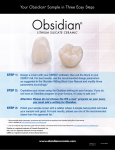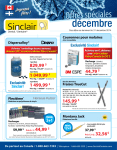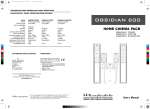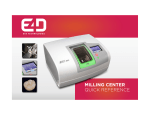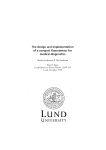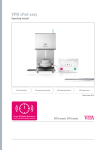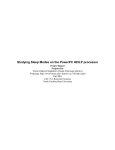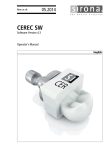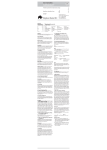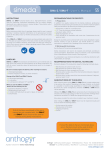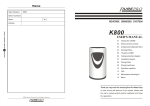Download Obsidian Milling Blocks User Manual
Transcript
User Manual 1. PRODUCT DESCRIPTION Obsidian® Milling Blocks are designed with an innovative combination of over 20 unique elemental oxides chosen from the periodic table (including Zirconia). Additionally, the Obsidian Milling Block owes its excellent properties due to a very high content of ultrafine nanometer-size lithium silicate and lithium phosphate crystals. The Obsidian Milling Block is a lithium silicate ceramic, supplied in a partially crystallized (nucleated) phase, with or without an attached mandrel, which is to be milled using CAD/CAM methods. The product can produce a variety of monolithic restorations with great esthetics, lifelike translucency, and high strength including full-contour crowns, posterior crowns, anterior crowns, partial crowns, inlays, onlays, and veneers due to its excellent machining properties. Obsidian Milling Blocks are available in the commonly used VITA® Classical and Chromascop® Bleach shades. The product comes in the following VITA Classical shades: A1, A2, A3, A3.5, B1, B2, B3, C1, C2, C3, D2, and D3 and Chromascop bleach shades BL1 and BL4. After milling, the restorations must be subjected to a crystallization cycle, where they achieve great esthetics, lifelike translucency, and high strength. The overall workflow/procedure for preparing a restoration using an Obsidian Milling Block is shown below (Figure 1). Preparation, Determine the Shade, Take (Digital) Impression Fabricate the Model (Not required if Digital Impression) Design the Restoration Crystallization and Stain/Glaze Cycle can be combined together (See Table 5) Milling Finish & Polish Crystallization Veneering (optional) Stain (optional) & Glaze Add-On (optional) Etch Figure 1: Overall workflow / procedure for preparing a restoration using an Obsidian Milling Block The crystallization process is fast, simple, easy-to-use and progressively increases the strength of the restoration from milling to final crystallization. 2. INDICATIONS The Obsidian Milling Block is used to fabricate ceramic dental prostheses in the nature of single-unit crowns for posterior and anterior applications using CAD/CAM methods. 3. CONTRAINDICATIONS There are no known contraindications. Page 2 of 22 4. TECHNICAL DATA TABLE Table 1 – Obsidian Properties (Type II, Class 3) (as measured according to ISO 6872) Coefficient of Thermal Expansion (CTE) (298-773K) 12.2 x 10^-6/K Flexural Strength (Biaxial) 385 +/- 45 MPa 404 MPa Weibull Characteristic Strength 5. MATERIALS/EQUIPMENT/TOOLS i. Milling Device ii. Contour Stone iii. Diamond Bur iv. Diamond Polisher v. Brush vi. Stain vii. Glaze (Powder or Spray Can) viii.Ceramic Firing Peg ix. Peg Paste x. Honeycomb Firing Tray xi. Dental Furnace (Ivoclar Programat® CS / CS2, EP 5000 / EP 5010, P Series, Whip Mix® Pro Series, VITA Vacumat 6000M, or similar furnaces) xii. GC Initial™ LF Veneering / Add-On Powders xiii.Flexible Polishing Wheel xiv.Glaze Rubber Wheel / Polish Paste and Buffing Wheel 6. DESIGN OF RESTORATIONS NOTE: Obsidian Milling Blocks undergo a linear shrinkage of ~0.1% during the crystallization process which has to be taken into account in the design stage. See Design Parameters on page 5. The preparation guidelines and the minimum thickness recommendations are shown in Table 2, Figure 2, and Table 3, respectively. Failure to comply with these recommendations may result in chipping, delamination, and/or fracture of the final restoration. For specific instructions on design of restorations, please refer to the applicable CAD manual designated for your CAD system. Table 2 - Preparation Guidelines Recommended Minimum Reduction Thickness for Full Anatomy Restorations Anterior Veneers Posterior Page 3 of 22 Single Units (standard) Labial/Lingual Incisal/Occlusal ≥ 1.2 mm ≥ 1.5 mm Margin Area (Shoulder/Chamfer) ≥ 1.0 mm Cervical Labial Incisal Edge ≥ 0.6 mm ≥ 0.6 mm ≥ 0.7 mm Margin Area ≥ 0.6 mm Buccal/Lingual Incisal/Occlusal ≥ 1.5 mm ≥ 1.5 mm Margin Area (Shoulder/Chamfer) ≥ 1.0 mm Prep Guide for All-Ceramic Restorations ANTERIOR FULL-COVERAGE CROWN ≥ 1.5 mm ≥ 1.2 mm ONLAY (PREMOLARS OR MOLARS) 1 mm 360° rounded shoulder B. Shoulder A. Full anterior wall thickness 1 to 1.5 mm wide gingival floor 1.0 to 2 mm isthmus width ≥ 1.2 mm ≥ 1.0 mm reduction ≥ 1.2 mm lingual clearance ≥ 1.0 mm ≥ 1.0 mm shoulder preparation ≥ 1.5 mm incisal reduction shoulder margin Rounded internal line angles POSTERIOR FULL-COVERAGE CROWN A. Shoulder ≥ 1.5 mm buccal and lingual reduction ≥ 1.5 mm occlusal B. Shoulder reduction Rounded ≥ 1.5 mm occlusal internal line reduction angles shoulder preparation VENEERS Rounded internal line angles Uniform Facial Preparation A medium-grit round-ended diamond is used to join the depth cut grooves to establish a uniform preparation and veneer thickness of ≥ 0.6 mm. margin ≥ 1.0 mm ≥ 1.5 mm buccal and lingual reduction INLAY (PREMOLARS OR MOLARS) ≥ 1.0 mm gingival margin reduction Veneers wall thickness ≥ 0.7 mm ≥ 1.0 mm Shoulder margin Rounded internal line angles ≥ 1.0 mm depth expulsive 6º angle minimum ≥ 0.6 mm expulsive 6º angle minimum shoulder preparation Figure 2: Preparation Guide for All-Ceramic Restorations For Inlays, a preparation depth of at least 1.0 mm and isthmus width of at least 1.0 mm must be observed in the fissure area. The proximal box should have slightly diverging walls and an angle of 100o –120o between the proximal cavity walls and the prospective proximal inlay surfaces should be observed. Slice-cuts or feather edges should be avoided. GL-4342-062215 Round out internal edges to prevent any stress concentration in the ceramic material. For Onlays, a preparation depth of at least 1.0 mm and an isthmus width of at least 1.0 mm must be observed in the fissure area. The proximal box should have slightly diverging walls and an angle of 100o –120o between the proximal cavity walls and the prospective proximal onlay surfaces should be observed. At least 1.0 mm of reduction in the cusp areas should be provided. Slice-cuts or feather edges should be avoided. Round out internal edges to prevent any stress concentration in the ceramic material. For Partial Crowns, at least 1.5 mm reduction in the cusp areas should be provided. A circular shoulder with rounded inner edges should be prepared. A deep chamfer can also be provided. The width of the shoulder/chamfer should be at least 1.0 mm. For preparation of all-ceramic restorations reduce uniformly while maintaining the original anatomical form (see Figure 2 for thickness reduction guidelines). Shoulder with a rounded inner edge or a chamfer with 10 to 30 degree angulation is preferred. The width of the circular shoulder/chamfer should be at least 1.0 mm. Page 4 of 22 For anterior restorations, minimum incisal third reduction of 1.5 mm and 1.2 mm of overall vestibular or occlusal reduction are recommended. For posterior restorations, minimum occlusal third reduction of 1.5 mm and overall all-around vestibular reduction of 1.5 mm is recommended. For conventional and/or self-adhesive cementation, retentive surfaces (with a minimum preparation height of 4.0 mm) are essential. The following design parameters can be used as a baseline (and may need to be changed slightly based on the each user’s unique settings and internal processes): Design Parameters Cement Gap: 0.020 mm Extra Cement Gap: 0.050 mm Distance to Margin Line: 1.000 mm Smooth Distance: 0.200 mm Drill Radius: 0.700 mm Drill Compensation: 0.400 mm Offset Angle: 65 degree Margin Line Offset: 0.150 mm Extension Offset: 0.070 mm Enlargement Factor (for milling software): 1.001** (also known as 0.1% shrinkage) **1.001 can be increased or decreased based upon scan, design hardware/software, milling machine, and furnaces. For optimum milling and restoration integrity, the following criteria are also recommended: • Margin area should be a shoulder or chamfer of at least 1.0 mm clearance with NO sharp angles. • For inlays and onlays, preparation has to be expulsive with at least a 6 degree angle. • P reparation should have no sharp angles. Always get a round preparation on margins, as well as on occlusal table and cuspid reduction. • Avoid significant changes in thickness confined to a small area within the restoration. • The cement gap thickness should be controlled in the design software and kept to a minimum. • The margin offset line in the design software should preferably be ≥150 microns. Table 3 – Minimum Thickness for Obsidian Milled Restorations (all dimensions in mm) Crowns Inlay Onlay Veneer Partial Crown Anterior Premolar Molar Circular 1.0 isthmus width 1.0 0.6 1.5 1.2 1.5 1.5 Incisal/Occlusal 1.0 isthmus width 1.0 0.7 1.5 1.5 1.5 1.5 More attention should be given to restoration design for best results and clinical success. The design of the software-generated restoration might have to be adjusted individually as required by the clinical situation. The minimum thickness must always be maintained. Page 5 of 22 7. MILLING (CAD/CAM PROCESSING) Obsidian Milling Blocks are designed for CAD/CAM procedures which utilize a milling device. These can be larger milling machines in the laboratory environment or chairside milling equipment which most likely use a mandrel system to secure the Obsidian Milling Block into a fixture (Figure 3). Please follow the manufacturer’s operating instructions specific to the CAM device in order to position the Obsidian Milling Block correctly. The CAD software needs to be followed in order to have a successful data transfer to the CAM device and a problem-free milling procedure. Figure 3: Chairside or lab milling machines (e.g., Sirona inLab® MC XL and IOS Technologies TS150™ CAD/CAM milling units, as shown) 8. FINISHING After milling, carefully remove the restoration from the still-attached block. Based on individual restoration requirements, finish the restorations using the suggested tools (Table 4). 1. Sprue removal 2. Sprue smoothening 3. Internal minor adjustment 4. Occlusal and proximal adjustment 5. Anatomy 6. Surface smoothening and texturing 7. Margin finish 8. Surface polishing Figure 4: Finishing guidelines for Obsidian Milled Restorations Table 4 outlines the suitable grinding tools to be used with Obsidian milled restorations. This is critical and failure to use these recommended tools may lead to edge and margin chipping, fractures, or local overheating. Grinding, adjusting or finishing should be performed gently at low speed (low RPM) using light pressure to avoid point (local) heating, damage, chipping or delamination. All diamond tools used on Obsidian restorations must be within the fine grit size range of 10 – 75 microns. Any diamond tool with a grit size above 75 microns is NOT recommended. If the restoration requires any grinding, make sure to polish the ground areas with a finer polish tool (i.e. high gloss) after grinding. All finishing is to be done prior to crystallization. The restoration should be checked on the model die (if available) for contacts, occlusion, fit, anatomy, surface texture and margin. After the crystallization cycle, it is recommended that NO additional finishing be performed. The minimum thickness must be maintained in all cases (after any major or minor adjustments). After finishing, and prior to crystallization, the restoration should be thoroughly cleaned with an ultrasound in a water bath or with a steam jet. It is strongly recommended NOT to sandblast or grit blast the restorations with glass beads or alumina. Page 6 of 22 Table 4 – Adjustment, Grinding, Finishing & Polishing Tools for Obsidian Milled Restorations (Part numbers are Meisinger Tool Part Numbers as an example – only use tools that are equivalent in grit size to these proposed tools below) Step Description 1 Remove restoration from the block 2 Smooth out the sprue Type: Burs/Stone Fine Diamond Cylindrical Shape #850F-014 (27µm-75µm) Pink Stone #9736G-150-HP Fine Diamond Cylindrical Shape #850F-014 3 Minor internal adjustment (27µm-75µm) Fine Diamond Donut Shape #909F-040 (27µm-75µm) 4 Proximal contacts and occlusal adjustment Pink Stone #9736G-150-HP Fine Diamond Inverted Cone #805F-014 (27µm-75µm) 5 Define anatomy Fine Diamond Football Shape #833F-023 (27µm-75µm) Page 7 of 22 Representative Pictures 6 Surface smoothening and texturing Pink Stone #9736G-150-HP 7 Margin finishing Blue Rubber Wheel Polisher #9770M-260-HP Blue Wheel #9752M-170 Surface polishing and occlusion 8 #9771M-170 *Users can choose lower speed (low RPM) tools and burs, as required (while ensuring that the respective grit sizes mentioned in the Table above are followed). 9. CRYSTALLIZATION All Obsidian milled restorations must go through the crystallization cycle. There are three options / possibilities: Option I: Crystallization and Glaze in one step (one heating cycle step - see Table 5) Option II: Crystallization, Stain and Glaze in one step (one heating cycle step - see Table 5) Option III: Crystallization in the first step (first heating cycle - see Table 5) and a separate stain & glaze step (second heating cycle - see Table 6). Crystallization and Stain/Glaze Cycle can be combined together (See Table 5) Milling Finish & Polish Crystallization Veneering (optional) Stain (optional) & Glaze Add-On (optional) Etch Figure 5: Overall preparation workflow/procedure for Obsidian Milled Restorations NOTE: It is not recommended to crystallize more than four units per crystallization cycle. NOTE: It is recommended to support the inside of the crown with firing paste and a peg when being subjected to crystallization. It is NOT recommended to just use a peg. Pegs may be modified by cutting their tip or by using a peg designed for posteriors which have no pointed tips. Fill the restoration with peg paste material (Figure 6a) without covering the margin. Page 8 of 22 Seat the restoration on a ceramic firing peg (Figures 6a, 6b) using the peg paste to stabilize the restoration during the firing cycle. (Do NOT use a metal peg.) Do not allow milled restoration to touch the peg or tray. Make sure the margins of the restoration are one to two millimeters above the tray. Place the restoration in the center of the firing tray (Figure 6c). Only use a standard honeycomb firing tray and a standard ceramic peg. NOTE: Firing trays made of other materials (like silicon nitride) are NOT recommended. Figure 6a: Peg paste Figure 6b: Peg paste application Figure 6c: Restorations placed on ceramic pegs placed on top of a honeycomb firing tray Use Table 5 for crystallizing Obsidian milled restorations. Table 5 – Crystallization Heating Cycle for Obsidian® Milled Restorations Ivoclar Programat® CS / CS2, EP 5000 / EP 5010, P Series Vacuum Quality 72 mbar Stand-by Temperature / Closing Time S 400°C Heating Rate t 1 90°C/min Holding Temperature T1 / Holding Time H1 Heating Rate t 2 780°C 10 seconds 40°C/min Holding Temperature T2 / Holding Time H2 Cooling Rate 3 minutes tL 820°C 10 minutes 50°C/min Long-term Cooling L 680°C Vacuum 1 Level V11(on) / V21(off) 400°C 780°C Vacuum 2 Level V12(on) / V22(off) 780°C 819°C Whip Mix® Pro Series Dry Time / Entry Temperature 3 minutes 400°C Rate Rise 1 / Hold Temperature 1 90°C/min 780°C Hold Time 1 (Pro 200 Only) 10 seconds Rate Rise 2 / Hold Temperature 2 40°C/min Hold Time 2 10 minutes Table Down / Cool Time 680°C Use Vacuum Yes Vacuum Level 72 Start Vacuum (Pro 200 Only) Rate Rise 1 400°C Release Vacuum (Pro 200 Only) Hold Time 2 0:00 Page 9 of 22 820°C 1 minute VITA® Vacumat 6000M Settings Menu Lift Speed Lowest ( 0 ) Temp Offset 25°C Standby Temp 400°C Program Menu Pre Drying Temperature / Pre Drying Time 400°C 3 minutes Pre Drying Lift Value A / B / C 30% 60% Pre Vacuum Value / Vacuum Value 100% 100% Gradient 90°C/min Firing Temperature / Firing Time 780°C Gradient 40°C/min Firing Temperature / Firing Time 820°C Cooling Temperature 680°C Lift Position 100% 90% 10 seconds 10 minutes NOTE: Step by step instructions for adding an Obsidian firing program for different model furnaces can be found at: www.ObsidianCeramic.com/resources. NOTE: Crystallization and Glaze can be done together following crystallization heating chart for the Obsidian Milling Block. DO NOT open furnace or remove the crystallized restorations until the furnace cools sufficiently for safe removal. The restoration should be protected from any drafts of air (Figure 6d). If the restorations are still hot, they must not be contacted with metal tongs, blasted or quenched. Figure 6d: Drafts of air are not recommended Refer to the operating instructions for the particular oven used for proper use, placement of the product and calibration. Ensure that the oven used is calibrated according to the particular manufacturer’s specifications. Contact your oven manufacturer for further instructions. Once crystallization has been completed, all of the residual peg putty material must be removed from inside the restoration before checking fit on the die or seating. Remove the bulk of the putty material with a metal tweezer. Any remaining putty material can be removed and cleaned by gently using a fine diamond cylindrical shape diamond bur (Table 4; #850F-014). Be careful not to chip the margin. Page 10 of 22 10. STAIN & GLAZE APPLICATION For chairside restorations, glazing is not always necessary. If stain & glaze is not desired, then hand polishing is suggested as an option which gives comparable results to glazing (use the polishing steps outlined in Table 6 as a guide). Prismatik™ Paste Stain and Prismatik Glaze are recommended for Obsidian milled restorations. Prismatik Glaze is a fluorescent glaze and is available in two forms – powder or spray can. Table 6 – Hand Polishing Obsidian Milled Restorations AFTER Crystallization (Only use the recommended tools below or their equivalents) Step 1 Polishing 2 Surface polishing and occlusion Type: Burs/Stone Representative Pictures Blue Wheel #9752M-170 (Meisinger) #9771M-170 (Meisinger) Diashine fine diamond paste 3 Polishing with diamond paste 4 Final polishing And Felt wheel #101-0891 (Zahn Dental Co.) Goat hair brush #090104543000220 (Meisinger) Follow the instructions for use included with the product for specific handling information for stain and glaze. Page 11 of 22 If desired, stain and/or glaze (Table 7) may be applied to the crystallized restoration, following which an independent Stain/Spray Glaze Heating Cycle must be performed (Table 8). Table 7 – Obsidian Stain and Glaze Starter Kit (Recommended for Obsidian® Milled Restorations) U.S. Accessories Available Through Prismatik Paste Stains Item Number Paste Stains Item Number Obsidian® Paste Stain Black, 3g (US) 70-1124-PUS0063 Obsidian® Paste Stain Violet, 3g (US) 70-1124-PUS0071 Obsidian® Paste Stain Brown, 3g (US) 70-1124-PUS0064 Obsidian® Paste Stain White, 3g (US) 70-1124-PUS0072 Obsidian® Paste Stain Blue, 3g (US) 70-1124-PUS0065 Obsidian® Paste Stain Yellow, 3g (US) 70-1124-PUS0073 Obsidian® Paste Stain Green, 3g (US) 70-1124-PUS0066 Obsidian® Paste Stain A, 3g (US) 70-1124-PUS0059 Obsidian® Paste Stain Gray, 3g (US) 70-1124-PUS0067 Obsidian® Paste Stain B, 3g (US) 70-1124-PUS0060 Obsidian® Paste Stain Ocher, 3g (US) 70-1124-PUS0068 Obsidian® Paste Stain C, 3g (US) 70-1124-PUS0061 Obsidian® Paste Stain Orange, 3g (US) 70-1124-PUS0069 Obsidian® Paste Stain D, 3g (US) 70-1124-PUS0062 Obsidian® Paste Stain Pink, 3g (US) 70-1124-PUS0070 N/A N/A Glazes Item Number Spray Glazes Item Number Obsidian® Glaze Liquid, 15mL (US) 70-1124-PUS0074 Prismatik Universal Low Fusing Ceramic Fluorescent Spray Glaze (Large Can-US) 70-1124-PUS0045 Obsidian® Fluorescent Low Glaze Powder, 5g (US) 70-1124-PUS0075 Prismatik Universal Low Fusing Ceramic Fluorescent Spray Glaze (Small Can-US) 70-1124-PUS0046 Stain and Glaze Kit Item Number Obsidian Stain and Glaze Starter Kit, (US) 70-1124-PUS0055 N/A N/A ® Accessories For Europe Available Through Prismatik Paste Stains Item Number Paste Stains Item Number Obsidian® Paste Stain Black, 3g (EU) 70-1124-PUS0080 Obsidian® Paste Stain Violet, 3g (EU) 70-1124-PUS0088 Obsidian® Paste Stain Brown, 3g (EU) 70-1124-PUS0081 Obsidian® Paste Stain White, 3g (EU) 70-1124-PUS0089 Obsidian® Paste Stain Blue, 3g (EU) 70-1124-PUS0082 Obsidian® Paste Stain Yellow, 3g (EU) 70-1124-PUS0090 Obsidian® Paste Stain Green, 3g (EU) 70-1124-PUS0083 Obsidian® Paste Stain A, 3g (EU) 70-1124-PUS0076 Obsidian® Paste Stain Gray, 3g (EU) 70-1124-PUS0084 Obsidian® Paste Stain B, 3g (EU) 70-1124-PUS0077 Obsidian® Paste Stain Ocher, 3g (EU) 70-1124-PUS0085 Obsidian® Paste Stain C, 3g (EU) 70-1124-PUS0078 Obsidian® Paste Stain Orange, 3g (EU) 70-1124-PUS0086 Obsidian® Paste Stain D, 3g (EU) 70-1124-PUS0079 Obsidian® Paste Stain Pink, 3g (EU) 70-1124-PUS0087 N/A N/A Glazes Item Number Spray Glazes Item Number Obsidian® Glaze Liquid, 15mL (EU) 70-1124-PUS0091 Prismatik Universal Low Fusing Ceramic Fluorescent Spray Glaze (Large Can-US) 70-1124-PUS0023 Obsidian® Fluorescent Low Glaze Powder, 5g (EU) 70-1124-PUS0092 Prismatik Universal Low Fusing Ceramic Fluorescent Spray Glaze (Small Can-US) 70-1124-PUS0024 Stain and Glaze Kit Item Number Obsidian® Stain and Glaze Starter Kit, (EU) 70-1124-PUS0056 N/A N/A Page 12 of 22 Table 8 – Stain/Glaze Heating Cycle for Obsidian Milled Restorations Ivoclar Programat or Similar Entry Temperature Entry Time VITA Whip Mix P Series, EP Series CS / CS2 Vacumat 6000M Pro Series 400°C 400°C 400°C 400°C 3 min 3 min 3 min 3 min 40°C/min 40°C/min 40°C/min 40°C/min Final Temperature 800°C 800°C 800°C 800°C Holding Time 1 min 1 min 1 min 1 min Lower Table 680°C 680°C 680°C 680°C Heating Rate t Use Vacuum Off Off Off Off Cool Time N/A N/A 1 min 1 min Apply stain and any characterization needed (Figures 7a, 7b). Figure 7a: Stain kit Figure 7b: Applying stain characteristics Figure 7c: Drying stain under furnace heat before glaze application When finished applying stain, you may place the restoration under the furnace to use the heat of the open furnace to dry the stains (Figure 7c) before applying any glaze. Once the stain has dried, allow the restoration to cool to room temperature in a place protected from drafts of air. After staining, the restoration is ready for glaze application. The glaze for Obsidian milled restorations is available in two forms – loose powder and (pressurized) spray can. The loose powder can be mixed with a liquid and then added to a spray bottle for ease of application. The (pressurized) spray can also be directly applied on to the Obsidian restoration. Apply the Prismatik Universal Low Fusing Ceramic Fluorescent Spray Glaze in thin even coats (Figure 8a). Before subjecting the restoration to the heating cycle, ensure that the restoration has been filled with peg paste material, and that the peg paste material does not cover the margin. Seat the restoration on a ceramic firing peg (Do NOT use a metal peg) to stabilize the restoration during the heating cycle. Place the restoration mounted on a peg with the peg paste at the center of the honeycomb firing tray (Figures 8b-8c). Avoid applying too thick of a glaze layer. Do not allow the milled restoration to touch the peg or tray during the firing cycle. Page 13 of 22 Figure 8a: Applying thin even glaze coats on to the restoration Figure 8b: Apply peg paste inside the restoration after stain and spray glaze has been applied Figure 8c: Placing the stained/ glazed restoration on to the peg (using plastic tongs) for stain/glaze heating cycle After the heating cycle has been completed, allow the oven to cool sufficiently (<100°C) in order to safely remove the restoration. DO NOT touch hot restorations with metal tongs. DO NOT attempt to speed up the cooling by quenching the restoration or introducing extra air currents over it. Allow the restoration to cool down sufficiently (<100°C) in a place protected from drafts of air (Figure 9). Figure 9: Drafts of air are not recommended Once the restoration is cool to touch, all of the residual peg putty material must be removed from the inside of the restoration. Remove the bulk of the putty material with a metal tweezer. Any remaining putty material can be removed and cleaned by gently using a fine diamond cylindrical shape diamond bur (Table 4; #850F-014). Be careful not to chip the margin. Carefully inspect the restoration to make sure that there are no cracks or chips (Figure 10). Figure 10: Stained and glazed restoration after cooling NOTE: Please ensure that the furnace is properly calibrated. Differences of up to 20°C have been measured between the displayed temperature and the actual temperature in the furnace chamber when out of calibration. If the glaze results are not to your satisfaction, please use 5°C increments when adjusting temperatures. If the glaze surface is not satisfactory then hand polishing can be done with a low speed handpiece. The steps are shown in Figure 14a–14c. 11. ADJUSTING THE CRYSTALLIZED RESTORATIONS It is recommended that NO additional finishing be performed after the restoration is in the crystallized and finished glaze phase. Page 14 of 22 12. OBSIDIAN MILLED RESTORATIONS VENEERING/ADD-ON POWDER APPLICATION If desired, Veneering and Add-On Powders can be used on crystallized Obsidian milled restorations. NOTE: Veneering step is done prior to glazing and after crystallization. Add-On step is done after the stain and glaze step. Both veneering and add-on are optional steps (Figure 11). Milling Finish & Polish Veneering (optional) Crystallization Stain (optional) & Glaze Add-On (optional) Etch Figure 11: Overall restoration preparation workflow/procedure for Obsidian Milled Restorations Recommended Veneering for Obsidian Milled Restorations (Optional) GC Initial LF Dentin GC Initial LF Enamel Note: Do not use any other veneering material for Obsidian milled restorations. Failure to comply with this recommendation may result in chipping, delamination, and/or fracture of the final restoration. Wash the restoration clean from any contamination and dry it completely prior to applying veneering material. To simplify, GC Initial LF six (6) shades of enamel and dentin can be used in various combinations to achieve all 16 shades for veneering. The recommended 6 shades are: Dentin A2, B2, C2, BLD-3 and Enamel E-57 and E-60. Use the appropriate combination ratio of enamel and dentin, as listed in Table 9, for build-up on restorations that need correction for chipped margins or standardized build-up (Figures 12a-b). Table 9 – GC Initial LF Kit for Veneering and Add-On for Obsidian Obsidian Milled Restoration GC Initial LF - Dentin GC Initial LF- Enamel BL1 BLD-3 (100%) N/A N/A BL4 BLD-3 (80%) B2 (20%) N/A A1 A2 (25%) N/A E-57 (75%) A2 A2 (50%) N/A E-57 (50%) A3 A2 (75%) N/A E-57 (25%) A3.5 A2 (100%) N/A N/A B1 B2 (25%) N/A E-57 (75%) B2 B2 (50%) N/A E-57 (50%) B3 B2 (75%) N/A E-57 (25%) C1 C2 (10%) N/A E-57 (90%) C2 C2 (25%) N/A E-60 (75%) C3 C2 (50%) N/A E-60 (50%) D2 A2 (10%) N/A E-57 (90%) Veneering material and distilled water are mixed in the appropriate ratio to achieve the desired consistency or use the manufacturer recommendations. The heating cycle for veneers is outlined in Table 10. After the veneering heating cycle has been completed, adjust contours as needed then stain if desired and apply spray glaze (refer to Section 10) Page 15 of 22 Figure 12a: Mixing Enamel/Dentin powder with distilled water for veneering Figure 12b: Building and contouring the cusps Table 10 – GC Initial LF Veneering Heating Cycle for Obsidian Ivoclar Programat or Similar VITA Whip Mix P Series, EP Series CS / CS2 Vacumat 6000M Pro Series Entry Temperature 400°C 400°C 400°C 400°C Entry Time 6 min 6 min 6 min 6 min 45°C/min 45°C/min 45°C/min 45°C/min Final Temperature 800°C 800°C 800°C 800°C Holding Time 1 min 1 min 1 min 1 min Vacuum V11(on) 400°C 400°C 400°C 400°C Vacuum V21(off) 800°C 800°C 800°C 800°C Lower Table 680°C 680°C 680°C 680°C Use Vacuum On On On On Cool Time N/A N/A 1 min 1 min Heating Rate t Note: No other Veneering material is recommended. No other heating cycle is recommended. Recommended Add-On for Obsidian Milled Restorations (Optional) GC Initial LF Dentin GC Initial LF Enamel NOTE: Do not use any other add-on material for Obsidian restorations. Failure to comply with these recommendations may result in chipping, delamination, and/or fracture of the final restoration. Page 16 of 22 Wash the restoration clean from any contamination and dry it completely prior to applying add-on material. To simplify, GC Initial LF six (6) shades of enamel and dentin can be used in various combinations to achieve all 16 shades for add-on. The recommended 6 shades are: Dentin A2, B2, C2, BLD-3 and Enamel E-57 and E-60. Use the appropriate combination ratio of enamel and dentin, as listed in Table 9, for build-up on restorations that need minor correction (Figures 13a-b). Add-On material and distilled water are mixed in the appropriate ratio to achieve the desired consistency or use the manufacturer recommendations. The heating cycle for add-ons is outlined in Table 11. After the Add-On heating cycle has been completed, adjust the contours or contacts. For finishing and polishing, follow the instructions mentioned in (Figures 14a-c) and see Table 12 for details. Figure 13a: Mixing Enamel/Dentin powder with distilled water for add-on Figure 13b: Building and contouring the cusp Note: No other Add-On is recommended. No other heating cycle is recommended. Table 11 – GC Initial LF Add-On Heating Cycle for Obsidian Ivoclar Programat or Similar VITA Whip Mix P Series, EP Series CS / CS2 Vacumat 6000M Pro Series Entry Temperature 400°C 400°C 400°C 400°C Entry Time 6 min 6 min 6 min 6 min 45°C/min 45°C/min 45°C/min 45°C/min Final Temperature 760°C 760°C 760°C 760°C Holding Time 1 min 1 min 1 min 1 min Vacuum V11(on) 400°C 400°C 400°C 400°C Vacuum V21(off) 760°C 760°C 760°C 760°C Lower Table 680°C 680°C 680°C 680°C Use Vacuum On On On On Cool Time N/A N/A 1 min 1 min Heating Rate t Page 17 of 22 Figure 14a: Blue rubber polisher #9752M-170 Figure 14b: Fine Diamond polishing with felt wheel Figure 14c: Final polishing with goat hair brush Table 12 – Finishing and Polishing Following Add-On Heating Cycle Steps Wheel/Brush/Type Surface and occlusal polishing Blue rubber polisher #9752M-170 (Meisinger) Felt Wheel 101-0891 (Zahn Dental Co.) Diashine Fine Diamond Polishing Paste Fine diamond polishing paste Goat Hair Brush 090104543000 (Meisinger) 13. CEMENTATION The restorations must be etched (5% HF for 10 sec) prior to cementing (Figures 15a-d). The etched surface should be thoroughly rinsed with water. Etching for longer time (more than 10 sec) or using a higher concentration (>5%) of HF etchant is NOT recommended. Dental professionals should use conventional cement, adhesive resin cements or self-adhesive resin cements for luting Obsidian restorations. It requires salinization or conditioning of bonding surface of the restoration. Adhesive resin cement is preferred for inlay, onlays and partial crowns. Anterior and posterior crowns can be cemented with conventional cement, adhesive resin cements or self-adhesive resin cements. Figure 15a: Incorrectly etched (no etching on select internal areas & margin edges) Page 18 of 22 Figure 15b: 5% HF etching gel applied inside the restoration Figure 15c: 5% HF etching gel applied all around the margin using a microbrush Figure 15d: Correctly etched restoration (internally and all around the margin edges) 14. IMPORTANT PROCESSING RESTRICTIONS The following restrictions, if not observed, may compromise the quality of the restorations and the results achieved. Failure to follow these guidelines may result in poor esthetics, chips, cracks, delamination, and/or fracture of the restoration. - The minimum thickness guidelines for the frameworks must be followed - The design parameters should not deviate significantly from the suggested baseline - Crystallization guidelines must be carefully followed in a properly calibrated furnace (with vacuum function) - After a heating cycle or a stain drying cycle, the restorations should not be cooled under air draft - Adjustment, finishing and polishing tools should be used at low speeds and with light pressure. All diamond tools must be of fine grit size (10–75 micron grit size) - Only the recommended stain, glaze, veneer, and add-on accessories are to be used with Obsidian restorations along with the recommended heating cycles - Care should be taken to etch the inner margins of the restorations (using a ceramic etching gel < 5% HF for 10 sec) - No grit blasting or sandblasting should be done on Obsidian restorations - Only use standard ceramic pegs on standard crystallization tray for all heating cycles 15. TROUBLESHOOTING Restorations are over-glazed or appear too glossy • Make sure to keep the glaze layers thin when spray glazing and avoid thick coats. • H eating cycle may be too high – decrease temperature in increments of 5°C until a satisfactory glaze surface is obtained Surface of the restoration lacks luster • Amount of spray glaze layers might be too thin • Increase temperature in increments of 5°C until the optimum glaze-luster achieve • Hand-polish to obtain the results similar to a glazed surface Restorations do not fit on the model or have open margin • Do not use a worn bur to mill the restoration. Replace bur • Calibrate the furnace • Use the correct design setting, correct design parameters, and correct enlargement factor setting • Apply adequate peg paste material inside the restoration to avoid warping during crystallization cycle • Ensure that the margins are not in contact with the firing tray. Raise them up to 1 millimeter above the tray • After the heating cycle, make sure to remove all residue peg paste material from the inside of the restoration Page 19 of 22 Restorations crack or fracture • Use only the recommended stain, glaze, veneer, and add-on along with the recommended heating cycle • Avoid heavy pressure when adjusting or grinding the restoration. Use low speed burs. • A llow the restoration to cool to room temperature without introducing additional air drafts which can cool down the restoration too quickly • Avoid using metal tongs on a hot restoration. • Ensure the restorations do not contact the ceramic pegs. Do not use metal pins. • Peg must not touch the restoration during crystallization, stain glaze, veneering and add-on. • Be sure to follow the recommendations for design parameters and minimum restoration thickness. • Avoid designs that contain a thick and thin junction in the occlusal area. • Avoid blasting with alumina or glass beads • Etch as per the guidelines – do not over-etch 16. STORAGE Before storing Obsidian blocks, ensure there is NO damage, including cracks and chips of the block. The blocks should be stored at room temperature and away from dust, contamination and humidity. When NOT in use, store blocks in the original packaging. 17. WARNING Do NOT inhale dust while preparing the restoration. Do NOT get dust into eyes or have prolonged contact directly with the skin. Personal Protective Equipment (PPE) such as gloves, masks and lab coats are recommended in order to avoid possible contact and irritation to skin or eyes during processing. To request the SDS for this product, call Glidewell Direct in the U.S. at 1-888-303-3975 18. QUESTIONS/COMMENTS For questions and/or comments, or for further instructions regarding the use of this product, contact Glidewell Direct in the U.S. at 18651 Von Karman Ave., Irvine, CA 92612 or call 1-888-303-3975. Page 20 of 22 19. SYMBOLS Consult Instructions for Use Manufacturer LOT only Batch Code By Prescription Only REF Catalogue Number Manufactured Date Caution Obsidian is a registered trademark of Prismatik Dentalcraft, Inc. Chromascop and Programat are registered trademarks of Ivoclar Vivadent, Inc. Whip Mix is a registered trademark of Whip Mix Corporation. GC Initial is a trademark of GC America, Inc. VITA is a registered trademark of VITA Zahnfabrik H. Rauter GmbH & Co. Prismatik is a trademark of Prismatik Dentalcraft, Inc. Page 21 of 22 0086 EC REP MDSS Schiffgraben 41 30175 Hannover, Germany Tel.: +49-511-62 62 86 30 Fax: +49-511-62 62 86 33 [email protected] Designed and Manufactured in the USA by (A wholly owned subsidiary of Glidewell Laboratories, Inc.) 2212 Dupont Dr. • Irvine, CA 92612 Page 22 of 22 3028415_2.0 GD-485-091115 ECO #3035434
























